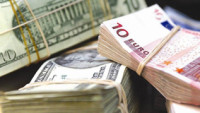 USD: Dollar consolidation continues
USD: Dollar consolidation continues
It has been a quiet week for the dollar. Last week’s dovish FOMC/soft NFP combination has taken the sting out of the dollar upside. Yet investors remain wary that another US core CPI release in the 0.3% month-on-month reading next week merely cements the view of the Fed keeping rates higher for longer. Speculation from Federal Reserve hawks that the policy rate may not be restrictive enough has failed to resonate in markets, however.
This has left the dollar range-bound. Equally, earning 5.3% per annum with a one-week USD deposit means that the bar is quite high for a dollar sell-off.
For today, developments outside of the US will probably have a greater say on the dollar. Were the Bank of England to surprise on the dovish side – adding weight to the Riksbank’s cut yesterday – the theme of US-European divergence could re-emerge and drag DXY a little higher, perhaps to the 105.75 area.
Apart from US initial claims today, the only noteworthy item on the US data calendar is the US Treasury auctioning $25bn of 30 year paper. The issue of the unsustainable US fiscal deficit continues to simmer. Yet, barring a disastrous auction, timing when this topic hits markets remains very challenging. Please also see our comment published last week on the US Balance of Payments and the seeming dependence on long term debt inflows.
EUR: Going steady
Holiday-thinned conditions in Europe this week plus light data calendars mean that EUR/USD has been going nowhere fast. It has to see EUR/USD breaking far from 1.0750, unless the BoE is demonstrably dovish and GBP/USD drags EUR/USD lower with it.
Elsewhere in Europe today, we have a National Bank of Poland rate meeting. Our team in Poland continues to position themselves slightly more on the hawkish side, where NBP communication might disappoint a market looking for a rate cut later this year. This sounds slightly positive for the Polish zloty.
GBP: Risk of a 7-2 vote today
It is an important day for sterling. The Bank of England announces its policy decision and releases its latest Monetary Policy Report. In our BoE preview comment, our UK economist James Smith felt that, while the BoE could sound more optimistic about the disinflationary path, it may be too early for the BoE to alter key language and prepare the market for a rate cut in June. Equally, our base case remains for an 8-1 vote today, with risk of 7-2, should Dave Ramsden join Swati Dhingra in voting for a rate cut. A 6-3 vote would surely be a big dovish surprise today and hit sterling.
At some point this summer we expect sterling to sell off, as it’s priced more like the ECB/euro cycle than the Fed/dollar. The question is whether BoE communication today triggers that adjustment or the adjustment happens in June, when softer UK services CPI could allow the BoE to turn more dovish at the June rate meeting and prepare the market for a rate cut in August.
Should the BoE fail to deliver a markedly dovish message today, we doubt sterling has to rally too hard. 1.2530/2550 and 0.8580 could be the limit of sterling’s rally for GBP/USD and EUR/GBP respectively. Larger sterling moves come on the downside should Governor Andrew Bailey open the door to a June rate cut – a move which would probably see market pricing of the 2024 BoE easing cycle shift from two to three cuts.
MXN: Banxico expected to hold, but signal future cuts
Last week’s softer turn in US rates and the lower volatility behind it have seen the high-yield Mexican peso perform well again. The peso later today faces the event risk of the Banxico policy meeting. Analysts are nearly unanimous in looking for an unchanged policy rate at 11.00%. This follows the 25bp rate cut in March. With Mexican growth coming in on the strong side and core inflation flattening out around the 4.50% area (April data is released today), Banxico is seen in no hurry to again move independently of the Fed. And interest rate swap markets price both Fed and Banxico easing cycles very similarly this year.
Banxico may well choose to keep its head down today given the proximity of the Mexican presidential election on 2 June. And given that the continuity candidate, Claudia Sheinbaum, is so far ahead in the opinion polls, we do not see the elections as proving much of a risk to the peso. However, we do think the inflation-adjusted, real peso is very strong – it is back to its 2008 highs. And we suspect authorities will have a problem were USD/MXN pushing below the 16.50 area again. For that reason, we suspect that Banxico will drop some clues today about a further rate at its June meeting, which could prove peso negative. Our baseline view continues to see the peso outperforming the steep forward curve – but not delivering the kind of nominal appreciation we’ve seen over recent years.












